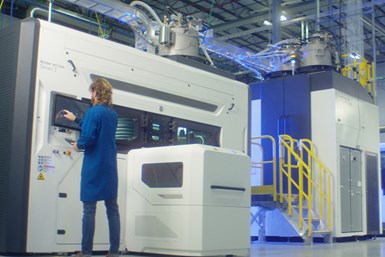GE Additive’s Binder Jet Line Series 3 for High-Volume, Serial Production
The system also enables users to depowder intricate parts without destroying fine features.
GE Additive’s Binder Jet Line and Series 3 printer is designed for high-volume, serial production environments. The company says the system can additively manufacture complex, small and large parts both repeatably and reliably, with excellent material properties that exceed casting equivalents with achievable through-hole diameters and wall thicknesses less than 500 μm.
The binder jet technology is said to have regularly proven the ability to successfully print and sinter large parts which meet dimensional and feature resolution tolerances for production, with demonstrated capability in (but not limited to) parts up to 25 kg in stainless steel and no known limitations on maximum wall thickness.
The Binder Jet Line also enables users to depowder intricate parts without destroying fine features. It can sinter parts within the desired tolerances, enabled in part by GE Additive’s Amp software’s distortion prediction and compensation capability. It is said it can develop casting equivalent or better, high-quality parts much faster than traditional methods. The system can also print and sinter parts with low surface roughness.
The system is said to offer cost efficiencies as well in cost comparisons to conventional manufacturing technologies. Less is spent on raw materials by recycling unused powder and leveraging less expensive material versus other powder bed technologies. It enables open space for new applications and innovation. It offers utilization of the entire build box — top to bottom, edge to edge — with no need for supports. It also enables the introduction of new innovative parts that would otherwise be too costly or difficult to manufacture with conventional or other existing additive technologies.
The company says the system also offers high overall equipment effectiveness (OEE), automation readiness, predictive distortion and compensation, and material properties that meet and exceed industry standards. All of these come together with the goal of lowest total cost of ownership for metal additive production.
It is said it has the ability to print up to 100X faster than other additive manufacturing modalities. The system features automation-ready technology that drives high productivity, and process and hardware designed to optimize Takt times.
It also enables seamless industrialization and integration into factory cells. The Binder Jet Line can be installed and operated without hazard zoning required and has been designed for minimal operator contact with the system and metal powders. The system will be UL listed and CE certified; has a 100% inert and sealed environment; fully closed- loop, powder-free exposure; and is designed for compatibility with reactive and flammable powder and binders.
Other safety benefits include zero operator powder exposure for powder load and operation; a fully independent and real-time safety system on-board constantly monitoring machine conditions; and real-time OPC UA data streaming for integration into factory MES and safety systems.
Related Content
-
VulcanForms Is Forging a New Model for Large-Scale Production (and It's More Than 3D Printing)
The MIT spinout leverages proprietary high-power laser powder bed fusion alongside machining in the context of digitized, cost-effective and “maniacally focused” production.
-
Why AM Leads to Internal Production for Collins Aerospace (Includes Video)
A new Charlotte-area center will provide additive manufacturing expertise and production capacity for Collins business units based across the country, allowing the company to guard proprietary design and process details that are often part of AM.
-
Top 10 Additive Manufacturing Stories of 2023
Laser powder bed fusion, proprietary AM processes, machining and more made our list of top 10 articles and videos by pageviews this year.
















